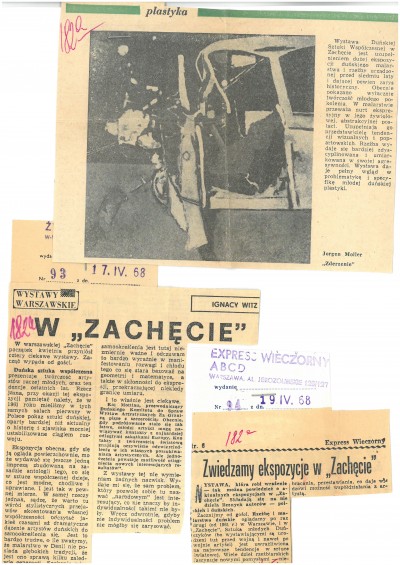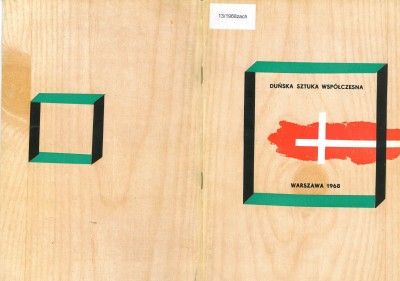Danish Contemporary Art
02.04 – 21.04.1968 Danish Contemporary Art
Zachęta Central Bureau of Art Exhibitions (CBWA)
organiser: CBWA
exhibition design: Marian Bogusz
poster design: Marcin Stajewski
number of artists: 29
number of works: 113
attendance: 12,393 (Rocznik CBWA [Annual of the Central Bureau of Art Exhibitions]) [total attendance for four exhibitions taking place at the same time]
Contrary to the large Danish art exhibition organised by the Central Bureau of Art Exhibitions in 1961,[1] this exhibition covered only the works of the young generation of Danish artists. Its context, as well as the source and authorship of the concept remain elusive. Officially, the exhibition was organised by the Central Bureau of Art Exhibitions under the patronage of the Ministry of Culture and Art, and on the Danish side, all the activities were carried out by the Committee for International Art Exhibitions. The exhibition was inaugurated by Minister of Culture and Art Lucjan Motyka, and attending was the Danish Ambassador.
The catalogue states that the works were selected by painter Kai Mottlau (1902–1984), a Colourist and an artist who fell into oblivion in Denmark, and who at that time chaired the Committee and wrote a short introduction.[2] In the text, he referred to the exhibition of Danish art at the Central Bureau of Art Exhibitions in 1961, and described the exhibition in 1968 as its continuation. In 1968, an exhibition of contemporary Polish painting was held in Copenhagen, as well as in Norway.
The exhibition of works at Zachęta (and the catalogue layout) was designed by Marian Bogusz, whose recent contacts with Denmark, where he organised and carried out Polish sculpture plein-air in Aalborg in 1967, may also give rise to suspicion of a wider involvement in this undertaking. The Danish exhibition featured two sculptures by Egon Fischer, with whom Bogusz co-exhibited in Aalborg. In 1967, Bogusz also composed his own exhibition of painting at Zachęta, and in May 1968, he worked on the Realisation and Proposals exhibition, ‘presenting the outcomes of the Aalborg Symposium’.[3] This was a period of particular intensification of spatial exploration in his work and this is also reflected in his arrangement of the Danish exhibition at the Central Bureau of Art Exhibitions.
The exhibition of contemporary Danish art at Zachęta was held simultaneously with three other shows — exhibitions of paintings by Eugenia Różańska and Leon Michalski, as well as a presentation of works by 14 young sculptors from Warsaw. It featured 17 sculptures and spatial structures, as well as 78 paintings by 26 Danish artists, mostly obtained from the artists themselves or from private collections. Two of the works came from the Ny Carlsberg Foundation, while one was loaned from the Statens Museum for Kunst in Copenhagen. The pieces represented various types and kinds of abstract art, op-art, as well as expressive neo-figuration.
The Danish exhibition in 1968 was described by Bożena Kowalska and Ignacy Witz. The former clearly stated that the exhibition did not differ in any way from similar art exhibitions in other countries. She said that the contemporary Danish art ‘is linked with the international leadership in new artistic endeavours’.[4] Another interesting opinion was presented in Tygodnik Kulturalny by Stefan Rassalski, who criticised the quality of the Danes’ message, comparing the 1968 exhibition with the presentation of ‘noble’ Danish paintings in Warsaw in 1938, which he recalled.[5] According to the critic, the young artists presented paintings that were ‘soulless and non-intellectual’. In spite of such voices, the exhibition, which was opened at Zachęta shortly after the events of March 1968, which transpired on the nearby streets near the University and the Polish Theatre, hardly resonated with the public.
Of the featured artist artists, only a few of them gained wider recognition and fame in the future, including Kirsten Dufour (born in 1941) — sculptor, later turned performer, who debuted with an individual exhibition in Denmark in 1968, currently her works can be found in the permanent exhibition of the Statens Museum in Copenhagen — who ‘presented torn human-shaped sculptures installed in the framework of an iron structure’;[6], as well as Per Kirkeby (born in 1938), a painter, poet, sculptor and stage designer, whose pieces are now exhibited in many of the most important museums around the world. Some of the most interesting figures featured at the exhibition included Stig Brøgger (born in 1941), who at that point started his artistic search in the spirit of American minimal art. Of course, we cannot forget about sculptor Ib Brasse (1923–2009), who at that time was already considered a classic of Danish art, and who moved to Paris in 1968. The exhibition at the CBWA in 1968 featured his Bronze Figure — the only work presented during the event which leaned towards expressionist tendencies (in this case to the American welding sculptors.)
Towards the end of the 1960s, there were still few exhibitions of Western contemporary art presented at the CBWA. The year 1966 saw contemporary Swedish art exhibited at Zachęta, as well as a broad cross-section of ‘contemporary trends’ in European and American painting from the collections of the Stedelijk Museum in Amsterdam and the Van Abbe Museum in Eindhoven (including three paintings by Asger Jorn, a Danish painter.) After a year of relative hiatus, the year 1968, which was very memorable for Polish culture, was exceptionally rich in this respect. January brought the exhibition of the Munich-based Tendenzen group, followed by a large exhibition of Pablo Picasso’s works held at Zachęta in February, exhibition of 100 works of Italian avant-garde in March, an individual exhibition of André Beaudin’s works in April and and an exhibition of contemporary French painting at the end of the year.
Danish art, on the other hand, after exhibitions at Zachęta in 1961, as well as an individual exhibition of Egill Jacobsen’s works in 1965, was becoming better and better known in Poland. In 1966, the Gdańsk Opera hosted an exhibition of Ole Bjoern’s painting; in 1970, the BWA Gallery in Bydgoszcz held the exhibition of the Danish Spiren group; and 1976 brought an individual exhibition of Gjedde Henning’s works at BWA Gallery in Olsztyn.
Andrzej Pieńkos
Institute of Art History of the University of Warsaw
This text was prepared as part of the ‘National Programme for the Development of Humanities’ of the Polish Minister of Science and Higher Education — research project The History of Exhibitions at Zachęta — Central Office of Art Exhibitions in 1949-1970 (no. 0086/NPRH3/H11/82/2016) conducted by the Institute of Art History of the University of Warsaw in collaboration with Zachęta — National Gallery of Art.
Bibliography
Catalogues:
- Matusińska, Maria, ed. Duńska sztuka współczesna, introduction: Kai Mottlau. Warsaw: Centralne Biuro Wystaw Artystycznych, 1968
- Matusińska, Maria, Barbara Mitschein, Ada Potocka, Helena Szustakowska, eds. Rocznik CBWA 1968–1969–1970. Warsaw: Centralne Biuro Wystaw Artystycznych, [1971], pp. 12–13
Source texts:
- (g). ‘Współczesna sztuka Danii’. Kurier Polski, no. 80, 1968
- Kowalska, Bożena. ‘Postawy i działania’. Współczesność, no. 9, 1968
- Rassalski, Stefan. ‘Cztery wystawy zagraniczne’. Tygodnik Kulturalny, no. 17, 1968
- Witz, Ignacy. ‘W „Zachęcie”’. Życie Warszawy, no. 93, 1968
Press mentions:
- Dziennik Bałtycki, no. 81, 1968
- Dziennik Ludowy, no. 81, 1968
- Express Wieczorny, no. 78, 1968
- Express Wieczorny, no. 84, 1968
- Express Wieczorny, no. 94, 1968
- Express Wieczorny, no. 96, 1968
- Gazeta Pomorska, no. 89, 1968
- Głos Pracy, no. 79, 1968
- Kultura, no. 15, 1968
- Kurier Lubelski, no. 82, 1968
- Kurier Polski, no. 76, 1968
- Słowo Powszechne, no. 96, 1968
- Stolica, no. 16, 1968
- Sztandar Młodych, no. 74, 1968
- Trybuna Ludu, no. 93, 1968
- Tygodnik Kulturalny, no. 14, 1968
- Zielony Sztandar, no. 29, 1968
- Życie Literackie, no. 14, 1968
- Życie Literackie, no. 16, 1968
- Życie Warszawy, no. 74, 1968
- Życie Warszawy, no. 81, 1968
Artists
Painting: Poul L. Andersen, Per Arnoldi, Stig Brøgger, Ole Heerup, Arne Heuser, Erik Lagoni Jakobsen, Per Kirkeby, Søren Kjaersgaard, Jørn Larsen, Freddie A. Lerche, Kai Lindemann, Edward Matwijkiw, Loui Michael, Jørgen Møller, Preben Reinicke, Arne Haugen-Sørensen, Bent Stubbe Teglbjaerg, Poul Winther; sculpture: Ib Braase, Ole Christensen, Kirsten Dufour, Egon Fischer, Kasper Heiberg, Knud Hvidberg, Erik Lynge, Gunvor Skole, William Soya, Jørgen Haugen Sørensen.
[1] Wystawa współczesnej sztuki duńskiej (4–21 May 1961). Cf. Rocznik CBWA 1959–1960–1961, ed. Helena Kęszycka, Tamara Bryjowa, Maria Matusińska, Barbara Mitschein, Warsaw: Centralne Biuro Wystaw Artystycznych, [1962], p. 55.
[2] Duńska sztuka współczesna, an introduction by Kai Mottlau, ed. Maria Matusińska, exh. cat., Warsaw: Centralne Biuro Wystaw Artystycznych, 1968, n.pag. [pp. 1–2].
[3] Regarding the subject of the plein-air in Aalborg, see: Realizacja i propozycje. Marian Bogusz, Jerzy Jarnuszkiewicz, Bronisław Kierzkowski, Magdalena Więcek, exh. cat., ed. Barbara Mitschein, Warsaw: Centralne Biuro Wystaw Artystycznych, 1968.
[4] Bożena Kowalska, ‘Postawy i działania’, Współczesność, no. 9, 1968.
[5] Stefan Rassalski, ‘Cztery wystawy zagraniczne’, Tygodnik Kulturalny, no. 17, 1968.
[6] Kowalska.
-
04.05 – 21.05.1961Exhibition of Contemporary Danish Art
The exhibition, held under the auspices of the foreign ministers of both countries, was one of the comprehensive reviews of the art of a capitalistic country that rarely took place in the 1960s. Although the exhibition was a response to the show of Polish abstraction organised in Copenhagen in 1959, it did not limit itself (contrary to the title) to the latest art.
Zachęta Central Bureau of Art Exhibitions (CBWA)CBWA
Danish Contemporary Art
02.04 – 21.04.1968
Zachęta Central Bureau of Art Exhibitions (CBWA)
pl. Małachowskiego 3, 00-916 Warsaw
See on the map

